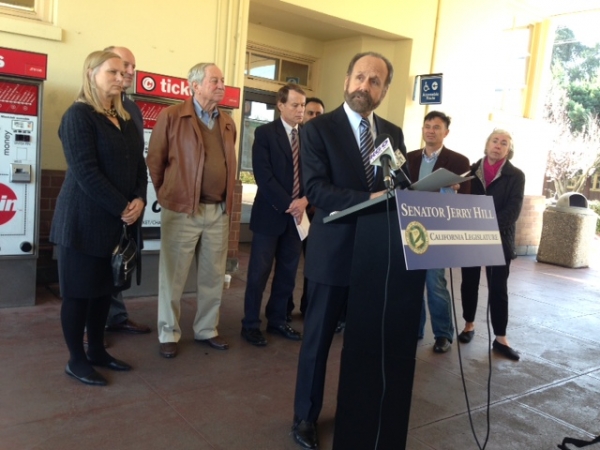As Caltrain prepares to embark on its long-stalled voyage toward electrification, Sen. Jerry Hill on Friday unveiled a bill that would bring the the project the funding it needs while, at the same time, ease local anxieties about the controversial high-speed rail line.
Senate Bill 557, which Hill introduced at Palo Alto's Caltrain station Friday morning, Feb. 22, seeks to ensure that the $68 billion high-speed rail project allocates funds for Caltrain's electrification, a project that Caltrain has been coveting for more than a decade but that has languished thus far because of nonexistent funding. Officials have long maintained that electrification is necessary to modernize Caltrain, allowing the agency to run more trains and reach financial sustainability.
The high-speed rail project, which California voters approved in 2008 and which remains deeply controversial on the Peninsula, offers Caltrain its first real chance at electrification. Senate Bill 1029, which legislators approved by a single vote in the state Senate last fall, allocates $1.1 billion for train improvements on the Peninsula. Hill's bill specifies that these funds include $600 million for electrification and another $105 million for advanced signal system.
The bill that passed last year also includes a loophole that would allow state officials to funnel money from the Peninsula project and allocate it to Central Valley, where the first segment of the rail system is set to be constructed. Hill's bill would close that loophole by guaranteeing that the money rail officials promised to Caltrain would not be transferred to other segments.
"I'm making it clear that Caltrain will receive the full funding intended by the state," Hill said at the Friday press conference, where his announcement was intermittently interrupted by the sound of passing trains.
The bill also seeks to turn other promises from California High-Speed Rail Authority officials into enforceable laws -- namely, the assurance from rail-authority officials that the rail system would be a "blended system" made up of two tracks shared by Caltrain and high-speed rail. The authority agreed in its most recent business plan to pursue such a system after a vehement outcry from Peninsula communities about the prior proposal, which called for a four-track system with Caltrain on the inside tracks and high-speed rail on the outside.
Hill's new bill would codify this promise in legislation. It would also give Peninsula communities some leverage over the project by giving Caltrain and eight Bay Area agencies a veto power over any future proposals to revisit the four-track alternative, which would increase the footprint of the controversial project and require more property seizures in Palo Alto and other cities along the Caltrain corridor.
Under the proposed legislation, a decision to revisit the locally unpopular alternative would require approval from nine different Bay Area agencies, including Caltrain, the Metropolitan Transportation Commission, the Santa Clara Valley Transportation Authority and the cities of San Francisco and San Jose. Hill called this provision a "critical safeguard" for the Peninsula communities.
"I think it will provide certainty and a peace of mind as we move forward toward electrification and, ultimately, high-speed rail," Hill said.
The proposal is Hill's first high-speed rail bill since his election last November to the state Senate, where his district includes much of the territory formerly represented by Sen. Joe Simitian, D-Palo Alto. Simitian, a leading rail watchdog who termed out last year and who now serves on the Santa Clara County Board of Supervisors, was one of the three architects -- along with U.S. Rep. Anna Eshoo, D-Palo Alto, and Assemblyman Rich Gordon, D-Menlo Park, of the "blended system" approach.
Santa Clara Supervisor Ken Yeager, who chairs Caltrain's board of directors and who joined Hill at the Friday press conference, said the board is in "full support" of Hill's legislation. He noted that next year will mark the 150th anniversary of passenger rail service on the Peninsula.
"These early investment funds set us on a course to thrive over the next 150 years," Yeager said.
Under the current plan, Caltrain electrification is slated to be completed by 2019.
While the bill lacks some of the provisions Palo Alto officials were hoping for -- including a guarantee that the four-track system would be completely off the table or a promise that the high-speed-rail project will stay largely within the Caltrain right-of-way -- council members rallied behind Hill's proposal.
Hill told the Weekly that he agreed to pursue the veto approach for the four-track design rather than simply ban future consideration of this design in consideration of the fact that opinions on the subject may change 20 or 30 years from now.
Allowing the possibility of a four-track approach and creating steep hurdles for revisiting this design is also more palatable politically for a project that squeaked through the state Senate by a single vote, with Simitian and several other Democrats joining the Republicans in opposition last year.
Hill said he worked with the Department of Finance and the rail authority on the "critical clarifications" in the bill and did not get pushback for his proposals from the state agencies. He said he is very confident the bill will pass.



Comments